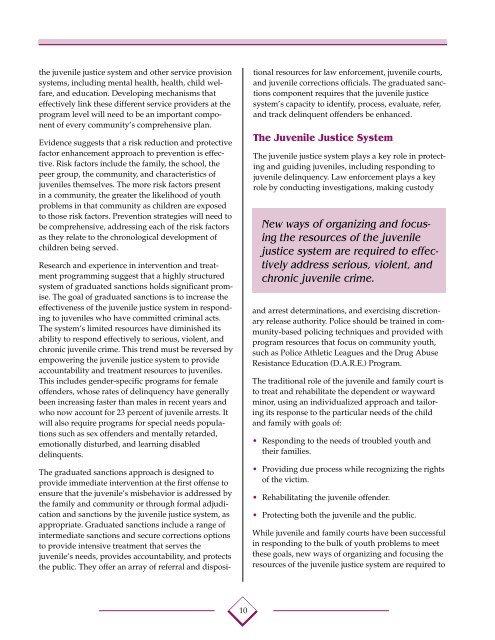uide for Implementing the Comprehensive Strategy for Serious ...
uide for Implementing the Comprehensive Strategy for Serious ...
uide for Implementing the Comprehensive Strategy for Serious ...
You also want an ePaper? Increase the reach of your titles
YUMPU automatically turns print PDFs into web optimized ePapers that Google loves.
<strong>the</strong> juvenile justice system and o<strong>the</strong>r service provision<br />
systems, including mental health, health, child welfare,<br />
and education. Developing mechanisms that<br />
effectively link <strong>the</strong>se different service providers at <strong>the</strong><br />
program level will need to be an important component<br />
of every community’s comprehensive plan.<br />
Evidence suggests that a risk reduction and protective<br />
factor enhancement approach to prevention is effective.<br />
Risk factors include <strong>the</strong> family, <strong>the</strong> school, <strong>the</strong><br />
peer group, <strong>the</strong> community, and characteristics of<br />
juveniles <strong>the</strong>mselves. The more risk factors present<br />
in a community, <strong>the</strong> greater <strong>the</strong> likelihood of youth<br />
problems in that community as children are exposed<br />
to those risk factors. Prevention strategies will need to<br />
be comprehensive, addressing each of <strong>the</strong> risk factors<br />
as <strong>the</strong>y relate to <strong>the</strong> chronological development of<br />
children being served.<br />
Research and experience in intervention and treatment<br />
programming suggest that a highly structured<br />
system of graduated sanctions holds significant promise.<br />
The goal of graduated sanctions is to increase <strong>the</strong><br />
effectiveness of <strong>the</strong> juvenile justice system in responding<br />
to juveniles who have committed criminal acts.<br />
The system’s limited resources have diminished its<br />
ability to respond effectively to serious, violent, and<br />
chronic juvenile crime. This trend must be reversed by<br />
empowering <strong>the</strong> juvenile justice system to provide<br />
accountability and treatment resources to juveniles.<br />
This includes gender-specific programs <strong>for</strong> female<br />
offenders, whose rates of delinquency have generally<br />
been increasing faster than males in recent years and<br />
who now account <strong>for</strong> 23 percent of juvenile arrests. It<br />
will also require programs <strong>for</strong> special needs populations<br />
such as sex offenders and mentally retarded,<br />
emotionally disturbed, and learning disabled<br />
delinquents.<br />
The graduated sanctions approach is designed to<br />
provide immediate intervention at <strong>the</strong> first offense to<br />
ensure that <strong>the</strong> juvenile’s misbehavior is addressed by<br />
<strong>the</strong> family and community or through <strong>for</strong>mal adjudication<br />
and sanctions by <strong>the</strong> juvenile justice system, as<br />
appropriate. Graduated sanctions include a range of<br />
intermediate sanctions and secure corrections options<br />
to provide intensive treatment that serves <strong>the</strong><br />
juvenile’s needs, provides accountability, and protects<br />
<strong>the</strong> public. They offer an array of referral and disposi-<br />
10<br />
tional resources <strong>for</strong> law en<strong>for</strong>cement, juvenile courts,<br />
and juvenile corrections officials. The graduated sanctions<br />
component requires that <strong>the</strong> juvenile justice<br />
system’s capacity to identify, process, evaluate, refer,<br />
and track delinquent offenders be enhanced.<br />
The Juvenile Justice System<br />
The juvenile justice system plays a key role in protecting<br />
and guiding juveniles, including responding to<br />
juvenile delinquency. Law en<strong>for</strong>cement plays a key<br />
role by conducting investigations, making custody<br />
New ways of organizing and focusing<br />
<strong>the</strong> resources of <strong>the</strong> juvenile<br />
justice system are required to effectively<br />
address serious, violent, and<br />
chronic juvenile crime.<br />
and arrest determinations, and exercising discretionary<br />
release authority. Police should be trained in community-based<br />
policing techniques and provided with<br />
program resources that focus on community youth,<br />
such as Police Athletic Leagues and <strong>the</strong> Drug Abuse<br />
Resistance Education (D.A.R.E.) Program.<br />
The traditional role of <strong>the</strong> juvenile and family court is<br />
to treat and rehabilitate <strong>the</strong> dependent or wayward<br />
minor, using an individualized approach and tailoring<br />
its response to <strong>the</strong> particular needs of <strong>the</strong> child<br />
and family with goals of:<br />
• Responding to <strong>the</strong> needs of troubled youth and<br />
<strong>the</strong>ir families.<br />
• Providing due process while recognizing <strong>the</strong> rights<br />
of <strong>the</strong> victim.<br />
• Rehabilitating <strong>the</strong> juvenile offender.<br />
• Protecting both <strong>the</strong> juvenile and <strong>the</strong> public.<br />
While juvenile and family courts have been successful<br />
in responding to <strong>the</strong> bulk of youth problems to meet<br />
<strong>the</strong>se goals, new ways of organizing and focusing <strong>the</strong><br />
resources of <strong>the</strong> juvenile justice system are required to

















